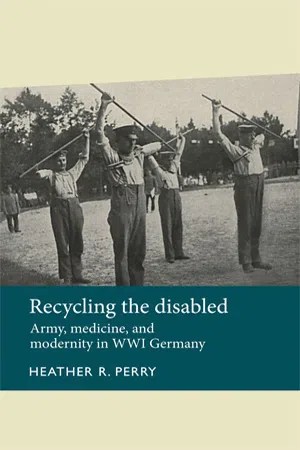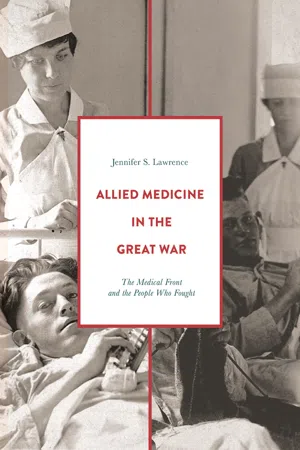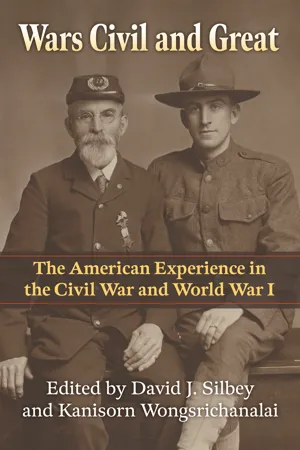History
Medicine on the Western Front
"Medicine on the Western Front" refers to the medical practices and challenges faced by healthcare professionals during World War I. It encompasses the development of field hospitals, advancements in surgical techniques, and the widespread use of new medical technologies. The harsh conditions and large number of casualties on the front lines presented significant obstacles for medical personnel, leading to innovations in trauma care and rehabilitation.
Written by Perlego with AI-assistance
Related key terms
Related key terms
1 of 4
Related key terms
1 of 3
3 Key excerpts on "Medicine on the Western Front"
- eBook - ePub
Recycling the disabled
Army, medicine, and modernity in WWI Germany
- Heather Perry(Author)
- 2015(Publication Date)
- Manchester University Press(Publisher)
28It was not until the 1990s that social historians of medicine began to take more seriously the topics of medicine and health in war time, and several important essay collections have emerged on this topic.29 Since then historians of medicine have been examining more closely the impact of the First World War on developments in modern medicine. Studies have pointed to the ways in which war provided an experimental laboratory for developments in such fields as pathological research, typhoid vaccinations, venereal disease, and pulmonary conditions.30 At first, this research concentrated primarily on war-related developments in British and American military and civilian medicine, but this is beginning to change. Susanne Michl’s published dissertation, Im dienste des Volkskörpers: deutsche und französische Ärzte im Ersten Weltkrieg, offers a discursive analysis of how doctors in war-time France and Germany perceived themselves and their medical work. Through an examination of medical journals published on both sides of the western front, Michl argues that medical experts envisioned themselves as health authorities whose work was crucial not only for individual survival, but also for the survival of the ‘national body’ (Volkskörper). Michl’s reliance on war-time medical journals and the words of professional elites written from the safety of the desk, however, results in a study which seems to miss the opportunity to examine the impact or lived experience of these attitudes on the population.31 One cannot help but wonder: how did the self-perceptions of these doctors translate into medical, military, or social policy towards others? What material impact did this medical discourse have on civilians, on soldiers, on military organisation? The recent collection War, Trauma, and Medicine in Germany and Central Europe (1914–1939) focuses specifically on how the war impacted on the practice, experience, and development of military medicine in the armies of the Central Powers. The essays in this book offer readers a glimpse into ways that the German and Austrian responses to trauma not only differed from those in Great Britain or America, but even from each other – thus reminding readers that soldiers in Central Europe did not have a uniform experience of injury or injury care.32 Daniela Angetter has examined Austrian military medicine and its evolution on the southern battle front once Italy entered the war; however, her study concentrates on how the terrain, climate and geographical location of battles on the Isonzo and in the Alps influenced medical and organisational practices specific to the Habsburg Army and not Germany.33 Leo van Bergen’s comparative book on soldiers’ experiences of the Great War synthesises a wide variety of primary and secondary sources which illuminate the horrors and suffering that Germans and others nationals endured on the Western Front, but these are presented more as episodes or vignettes than deep analyses or discussions of military medicine.34 - eBook - ePub
Allied Medicine in the Great War
The Medical Front and the People Who Fought
- Jennifer S. Lawrence(Author)
- 2018(Publication Date)
- Bloomsbury Academic(Publisher)
© Jennifer S. Lawrence, under exclusive licence to Macmillan Publishers Ltd, part of Springer Nature 2019 Jennifer S. Lawrence Allied Medicine in the Great War https://doi.org/10.26777/978-1-352-00420-5_5Begin AbstractEnd Abstract5. Effects of the Medical Front in the Great War
As the war wrapped up, doctors and other caregivers turned their time and thoughts to other concerns than the daily grind of work. The outbreak of influenza was ratcheting up and certainly occupied the focus of many in these waning months of the conflict; it would continue to do so into the early part of 1919. Some looked forward to demobilization after the armistice, hoping that the peace talks in 1919 would bring about a period of harmony after these long years of fighting. Soldiers excitedly looked forward to returning to their families and homes. Others approached the future with questions arising out of their time on the front. How could the new medical practices honed during the war be taken back to the civilian side of medicine? The success of the civilian medical endeavors was not simply proving the merit of the medical innovations and knowledge from the war; it also involved often personnel effort by individual physicians to spread that learning themselves.That medical practice in general would benefit from the knowledge and learning achieved on the medical front was a given. This was true with all war. With so many opportunities to hone their craft, doctors emerged from war knowing better treatment methods. In an article for the British Medical Journal right at the end of the war, Professor James H. Nicoll noted, “A large measure of revision of our standard books, however, will be necessary in the light of the experience of the war.”1 - eBook - ePub
Modern War Studies
The American Experience in the Civil War and World War I
- David J. Silbey, Kanisorn Wongsrichanalai(Authors)
- 2024(Publication Date)
- University Press of Kansas(Publisher)
The time from the Civil War to the Great War was one practice life, albeit a long one; yet the differences are profound. The Civil War found American medicine in social and professional disarray, with little impetus or hope of transformation. And yet as Billings recalled years later, “Looking back at the war as I remember it, it is a wonder that so many of the medical officers did as well as they did, and that the results were as good as they were.” But the leadership of army medicine, using the unique social and legal situation of military life in time of war, introduced over 30 percent of the regular practitioners in Union states to the best of scientific medicine at the time, who were inspired to take that elevated commitment to science and patient care home with them to the industrial cities and towns where they practiced. This jump start was accelerated by European science in the last two decades of the nineteenth century, and American medicine came to be better positioned to assist the military with its challenges of preparedness, sickness, and wounds. Meanwhile, the public commitment to caring for those who went in harm’s way on behalf of the balance of society led to improving standards of continuing education and the prosecution of innovation in a host of areas that helped change medicine in the postwar period. Perhaps the greatest change was the recognition that the scientific impetus generated in the Civil War had reached the point by the Great War that a single practitioner could not manage it all. The brief wartime experience would not solidify changes in medical education or specialization (that would come with yet another war); but it did illustrate the challenges of a medical science that had removed all questions about the social utility of medicine and the need to make it available to Americans. The explicit question was how ? Dr
Index pages curate the most relevant extracts from our library of academic textbooks. They’ve been created using an in-house natural language model (NLM), each adding context and meaning to key research topics.
Explore more topic indexes
Explore more topic indexes
1 of 6
Explore more topic indexes
1 of 4


